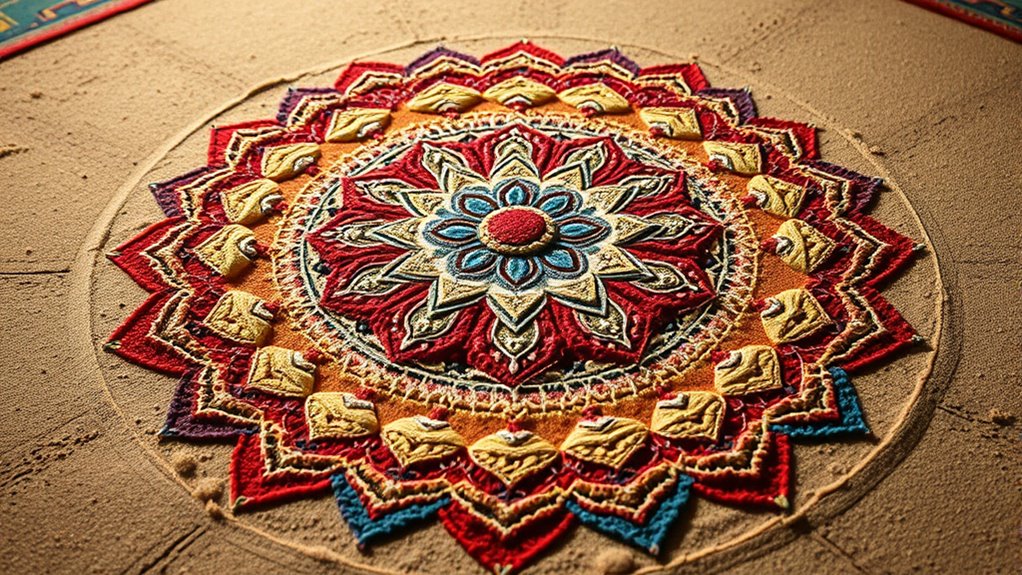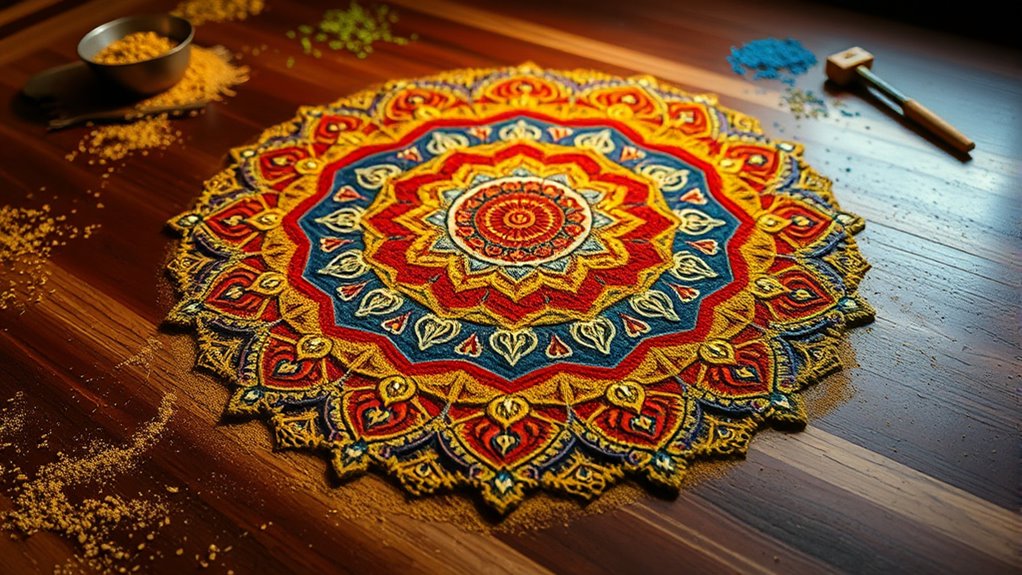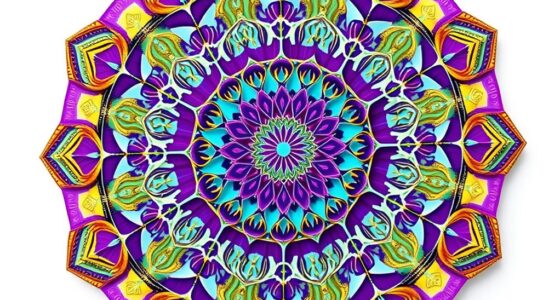Tibetan sand mandalas are stunning sacred artworks that embody Buddhist teachings on impermanence. As you observe their intricate patterns and vibrant colors, you’ll see how monks painstakingly create these temporary designs, knowing they will be dismantled to symbolize life’s fleeting nature. This process teaches patience, mindfulness, and the acceptance of change. If you explore further, you’ll discover the profound spiritual lessons behind their ephemeral beauty and what they reveal about life’s impermanent nature.
Key Takeaways
- Tibetan sand mandalas are intricate artworks symbolizing cosmic harmony and spiritual teachings, crafted by monks with meticulous detail.
- The creation process is a spiritual practice emphasizing patience, focus, and devotion, reflecting Buddhist principles.
- Mandalas embody impermanence, as they are dismantled after completion to symbolize the transient nature of life and material things.
- The scattering of sand into water represents the flow of impermanence, reinforcing lessons on change and acceptance.
- These sacred art forms serve as tools for meditation, mindfulness, and spiritual growth, embodying compassion, wisdom, and interconnectedness.

Tibetan sand mandalas are intricate, colorful artworks created by skilled monks as a spiritual practice and teaching tool. As you observe these detailed designs, you realize they serve a purpose beyond their stunning appearance. They are deeply embedded in meditative practice, helping practitioners focus their minds and cultivate mindfulness. When monks meticulously place each grain of colored sand, they aren’t just creating art—they’re engaging in a form of meditation that promotes concentration, patience, and inner calm. This process encourages you to see the mandala as more than just a visual creation; it’s a living symbol of spiritual symbolism that embodies the universe’s harmony and interconnectedness. The vibrant colors and complex patterns aren’t random but carefully chosen to represent various aspects of Buddhist philosophy, such as compassion, wisdom, and the impermanence of all things.
As you learn more about their significance, it becomes clear that Tibetan sand mandalas are a profound expression of spiritual symbolism. Each element within the design has specific meaning, serving as a visual language conveying teachings about the cycle of life, death, and rebirth. The symmetrical, geometric patterns symbolize the cosmos, while the central points and surrounding motifs guide your focus inward, encouraging reflection on your spiritual journey. Creating these mandalas is a deliberate act of devotion, and the entire process is a reminder of the transient nature of existence. The monks’ careful work underscores the Buddhist belief that attachment to material things is fleeting, emphasizing the importance of cultivating spiritual virtues instead. Additionally, the process of constructing the mandala often involves intricate symbolic representations, further deepening its spiritual significance.
You might notice that the creation of a sand mandala is not meant to last forever. Once completed, the monks perform a ritual to dismantle the artwork, scattering the sand into a body of water. This act embodies the core teaching of impermanence, reminding you that all things are subject to change. Observing this dissolution can be a powerful experience, urging you to embrace change with equanimity and to understand that attachment leads to suffering. The process of constructing and then destroying the mandala is a sacred ritual, highlighting the importance of impermanence as a fundamental truth in Buddhist philosophy. Through this cycle, you’re encouraged to reflect on your own life, recognizing the fleeting nature of material possessions and emotional states, and to seek spiritual growth that transcends temporary worldly attachments.
Frequently Asked Questions
How Long Does It Take to Create a Tibetan Sand Mandala?
It typically takes several days to weeks to create a Tibetan sand mandala. During this meditative process, you focus deeply on each detail, turning artistic expression into a spiritual practice. The time varies depending on the complexity and size of the mandala, but this careful, deliberate effort emphasizes impermanence and devotion. As you work, you learn patience and mindfulness, knowing the final act is its destruction, symbolizing life’s transient nature.
What Materials Are Used to Make the Sand for Mandalas?
Ever wonder what makes the vibrant colors in a sand mandala? You use natural pigments to create colored sand, which is carefully ground into fine grains. These natural pigments come from minerals, plants, and other organic sources, ensuring the colors are vivid and pure. The sand itself is usually a mix of colored sands or sometimes white sand, all chosen for their symbolic and aesthetic qualities.
Can Anyone Participate in Creating or Dismantling the Mandala?
Yes, you can participate in creating or dismantling the mandala, as these activities encourage community involvement and cultural accessibility. Many monasteries and cultural events invite volunteers and visitors to observe or even help with the process. This participation allows you to connect deeply with the tradition, understand its spiritual significance, and experience the temporary, sacred nature of the art firsthand. Your involvement fosters respect and appreciation for this ancient practice.
What Rituals Are Performed During the Mandala’s Destruction?
During the mandala’s destruction, you perform meditative prayers and ritual offerings to honor its impermanence. As the sand is carefully swept away, you focus on the spiritual significance, symbolizing life’s transient nature. This process involves chanting mantras and making offerings to express gratitude and promote compassion. You understand that dismantling the mandala is a sacred act, reinforcing the teachings of impermanence and interconnectedness.
How Do Mandalas Influence Spiritual Practice Outside Tibet?
Imagine walking into a quiet space where vibrant sand patterns guide your meditative focus, revealing deep cultural symbolism beyond Tibet. Mandalas influence your spiritual practice by fostering mindfulness, concentration, and a sense of impermanence. They serve as powerful visual tools that connect you to universal truths, inspiring reflection and inner growth. Their intricate designs and transient nature remind you that spiritual transformation is a continual, evolving process, regardless of your cultural background.
Conclusion
As you watch the vibrant sands dissolve, remember that impermanence is the soul of these sacred art forms. Like a delicate rainbow vanishing at dawn, the mandala teaches you life’s fleeting beauty and spiritual journey. Embrace the transient nature of existence, for in letting go, you find true understanding. The sands may fade, but their profound message remains etched in your mind, a shimmering reminder that everything is temporary, yet infinitely sacred.











